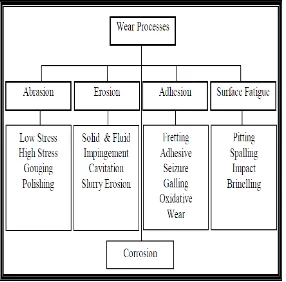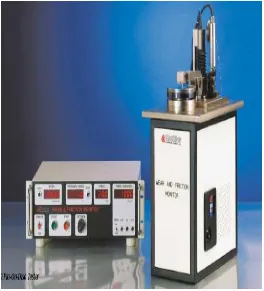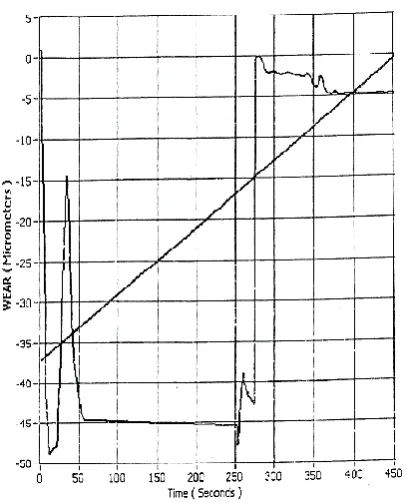Selection of the Material on the Basis of Wear
and Friction in Journal Bearing
Sanjay Kumar
1, Dr. S. S. Sen
2P.G. Student, Department of Mechanical Engineering, Green Hills Engineering College, Kumarhatti, Solan, H.P, India1 Associate Professor, Department of Mechanical Engineering, Green Hills Engineering College, Kumarhatti, Solan, H.P,
India2
ABSTRACT: The importance of friction and wear control cannot be over emphasized for economic reasons and long-term reliability. The savings can be substantial, and these savings can be obtained without the deployment of investment. Tribology is crucial to modern machinery which uses sliding and rolling surfaces. This article describes the tribological behavior analysis for the conventional materials i.e. PTFE (Graphite), Nickel, Nickel Chrome, Molybdenum Disulphide and New nonmetallic material Nylon. Friction and Wear are the most important parameters to decide the performance of any bearing. In this paper attempt is made to check major tribological parameters for these five materials and try to suggest better new material compared to conventional existing material. After Test on wear machine we found that MoS2 is best suitable for bearing applications because of its low wear rate, low frictional force,
low coefficient of friction, low cost, better mechanical properties than others.
KEYWORDS:Bearing, Friction, Frictional Force, Tribology, Wear
I. INTRODUCTION
Tribology is defined as the science and technology of interacting surfaces in relative motion, having its origin in the Greek word tribos meaning rubbing [1]. It is the study of the friction, lubrication and wear of engineering surfaces with a view of understanding surface interactions in detail and then prescribing improvements in given applications. One of the important objectives in Tribology is the regulation of the magnitude of frictional force according to whether we require a minimum or a maximum.
This objective can be realized only after a fundamental understanding of the frictional process is obtained for all conditions of temperature, sliding velocity, lubrication, surface finish and material properties [2]. Tribology is crucial to modern machinery which uses sliding and rolling surfaces. Examples of productive friction are brakes, clutches, driving wheels on trains and automobiles, bolts, and nuts. Examples of productive wear are writing with a pencil, machining, polishing, and shaving. Examples of unproductive friction and wear are internal combustion and aircraft engines, gears, cams, bearings, and seals.
Figure 1: types of wear
Voong et al.[4] were examined the wear properties of Al–Si alloys used in the crankshaft bearings of internal combustion engines under two fully formulated lubricants, which have the same viscosity grade. It was found that in a completely ferrous‐based system fully formulated lubricants are effective in reducing wear and friction.
Gwidon W. Stachowiak et al [5] describes the fundamental wear mechanisms operating in non-metallic materials together with some prognoses concerning the future developments of these materials. Two classes of materials with entirely different characteristics polymers and ceramics are discussed. Polymers can provide low friction and low wear coefficients but their use is limited to lower temperatures and consequently low speeds and loads. Ceramics are resistant to high temperatures and often have a good wear resistance but their applications are limited by poor friction coefficients, especially in unlubricated applications. Ceramics and polymers are surprisingly vulnerable to accelerated wear in the presence of corrosive reagents and care should be taken in the selection of materials that are appropriate for particular operating conditions.
Bekir Sadik Unlu et al [6] were investigated friction coefficient of bronze radial bearings by a new approach. The result shows that high friction coefficient and high wear have been observed in dry test conditions and the lubricated conditions have low friction coefficient and low wear have been observed.
E. Feyzullahoglu et al. [7] discussed the tribological behavior of tin based alloys and brass in oil lubricated conditions. It is shown that the performance of brass under oil lubrication is better than tin based alloys due to its hardness. The wear in brass is lower than the tin‐based alloys under similar tribological loading conditions.
as a function of the applied normal load by measuring the temperature of lubricating oil and coefficient of friction. The results showed that the Al alloy journal bearings reduce the friction coefficient by 28 % compared to the PTFE composite bearings and the PTFE composite journal bearings exhibited strong adhesion at the loads ranging from 6300 to 8000 N. Based on this experiment the Al alloy is a more promising material in journal bearings than PTFE composites.
Jiang and Xie [9] were investigated the tribological behavior of plasma‐spray TiO2 coating pairing with conventional
metallic bearing materials and triphenyl thiophosphate and tricresyl phosphate. The results shown that the copper– lead alloy paired with TiO2 coating lubricated with the base oil exhibited the optimum tribological performance.
S. Srivastava et al [10] studied a modified impeller mixing coupled with chill casting technique was used for the preparation of Al-Fe composite. The electrolytic grade iron powder of 300 mesh size was dispersed in the melt of commercially pure aluminum. The ductility showed the adverse effect with increase of the iron content in the matrix. The results from microstructure showed the presence of second phase particles at the grain boundaries of aluminum-rich phase as well as within the grain itself which was confirmed by EPMA line as well as XRD analysis.
Alves et al. [11] were studied the development of vegetable based lubricants and the tribological behavior of nanoparticle additives in an oil base. The results showed that the addition of nanoparticles to conventional lubricant, the tribological properties can be improved, the friction and wear can be reduced due to formation of tribo film on the worn surface. The lubricants developed from modified vegetable oil can replace mineral oil, improving the tribological and environmental characteristics.
Arumugam et al. [12] studied comparative of the tribological properties of chemically modified rapeseed oil with and without Nano‐ and micro scale titanium dioxide (TiO2) particles and investigated the influence of TiO2 particles to
reduce the friction and wear in chemically modified rapeseed oil. The results showed that the TiO2 nanoparticles
exhibited good friction reduction and anti‐wear properties compared with the micro scale TiO2 and without TiO2
additives to chemically modified rapeseed oil.
T. Miyajima et al [13] investigated the friction and wear behavior of Al–Sn–Si alloy with MoS2 layer under lubricated
condition by a reciprocating friction tester. It became clear that the Al–Sn–Si alloy with MoS2 layer showed about 70%
lower friction and about 1/10 lower wear depth compared to the Al–Sn–Si alloy. The worn surfaces of the Al–Sn–Si alloy with MoS2 layer were observed and analyzed by a SEM, a TEM and an EDX. It indicated that the sliding surface
of the counter face had larger area of Mo than the area of Al which was transferred from the Al–Sn–Si alloy with MoS2
layer by sliding, resulting in low friction and high wear resistance.
II. EXPEERIMENTAL SETUP
In this paper, the bearing materials like Nickel, Nickel Chrome, Molybdenum Disulfide, PTFE and Nylon which are widely used in industry. These materials are investigated in order to find the possible consequences of wear and friction. The diameter and the length of the pins are 10 mm and 30 mm respectively. For the same surface conditions, the top surfaces of each pins are finished with abrasive paper. The wear rate will be relatively small in most of the machinery and engineering tool. For measuring wear, we are using some apparatus and instruments which give results about the wear rate in the tools and machinery.
Figure 2: Pin-on-Disc Tribometer
Specifications of the test rig is given in Table 1.
Table 1: Specifications of pin-on-disk Tribometer (TR-20LE)
Pin Size 3 to 12 mm diameter.
Length of pin 30 mm
Disc Size 165 mm diameter × 8 mm thick Wear Track Diameter (Mean) 50 mm to 100 mm
Pitch circle Diameter 155 mm
Disc Rotation Speed 100-2000 RPM
Normal Load 0 N to 200 N.
Friction Force 0 to 200 N, digital recorded output
Wear Measurement Range 0 to 4microns.
Surface roughness 0.02 microns
Material of disc EN8
Hardness of disc material 58 to 62 HRC
Pin Material MS
Lubricant used 20W40 (HP)
Specification of Materials to be tested in the same conditions are given in the table 2.
Table 2: Specification of Materials to be tested
Materials Densit y Kg/m3 Poisso n’s Ratio Young’ s Modul us MPa Melti ng Point º C
Color Remarks
Molybdenu m Disulfide
5060 0.3 3*105 1185 Black Mo60S40
Nickel Chrome
8400 0.30 2.2
*105
1400 Silver Grey
Ni80Cr20
Nickel 8500 0.31 2*105 1455 Silver
white Ni
PTFE 2200 0.46 0.5*105 320 Black Polytetrafl
uoroethyle ne
Nylon 1150 0.39 3.28*10
4 225 Blue Cast
nylon6
Test conditions for different materials are shown in table 3.
Table 3: Testing conditions
Testing hours 60 min.
Speed 1000 rpm.
Velocity 1.07 m/s
Weight 10 kg
Wear track radius 80 mm
Pin diameter 10 mm
III. OBJECTIVES
To Study the wear behavior of the different selected materials under the same conditions that is speed, load, lubrication and time.
To study the relationship between coefficient of friction, frictional force, speed and load.
To suggest the best suitable material for the journal bearing applications from the tested materials.
IV. RESULTS AND DISCUSSION
The tests has been done on five different materials and its values are given in Tables. With the help of software and arrangement made in the wear equipment made by Win Ducom. It is possible to record readings at different time spans and for the 60 Minutes test duration 50 readings were recorded for the Wear, frictional force and Coefficient of friction.
Table 4: Observations for PTFE material
Sr. No.
Time (seconds)
Wear (microns)
Frictional Force (N)
Coefficient of friction
1 1.953 2.47 -0.45 -0.01
2 27.234 7.75 -0.06 -0.01
3 1095.765 10.2 0.4 -0.01
4 1260.437 10.68 0.33 0
5 1350.609 10.81 0.5 -0.01
6 1783.812 13 1 -0.01
The test result for wear rate for PTFE material is shown in fig 3.
Figure 3: Graph of Wear Vs. Time of PTFE
From the result in Fig. 3, shows the wear of the specimen increases rapidly and then gradually increased and thus giving considerable high wear rate.
(2) Material: Nickel
Table 5: Observations for Nickel material
Sr. No.
Time (seconds)
Wear (microns)
Frictional Force (N)
Coefficient of friction
1 1.969 9.36 1.35 0
2 35.297 9.11 0.7 0
3 152.906 7.75 0.68 0
4 217.594 6.68 0.67 0
5 490.078 4.68 0.65 0
The test result for wear rate for Nickel material is shown in fig 4.
Figure 4: Graph of Wear Vs Time of Nickel
From the result in Fig. 4, shows the wear of the specimen increases rapidly and after some interval it increases gradually and thus giving considerable high wear rate.
(3) Material: Nickel Chrome
Table 6: Observations for Nickel Chrome material
Sr. No.
Time (seconds)
Wear (microns)
Frictional Force (N)
Coefficient of friction
1 0.969 10.76 13.67 -0.01
2 9.797 12.98 -9.02 -0.01
3 330.297 18.02 0 -0.01
4 1268.266 17.11 0.38 -0.01
5 2153.313 14.29 1.76 -0.01
The test result for wear rate for Nickel material is shown in fig 5.
Figure 5: Graph of Wear Vs. Time of Nickel Chrome
From the result in Fig. 5, shows the wear of the specimen increases rapidly and then decreases gradually, and becomes constant after some time. Therefore this material giving a wear rate which is more.
(4) Material: Molybdenum Disulphide
Table 5: Observations for Molybdenum Disulphide material
Sr. No.
Time (seconds)
Wear (microns)
Frictional Force (N)
Coefficient of friction
1 1.953 -1.28 -14.25 -0.01
2 43.125 0.28 0.04 -0.01
3 74.484 0.18 0.08 -0.01
4 103.891 0.14 0.18 -0.01
5 327.359 0.7 0.33 -0.01
The test result for wear rate for Molybdenum Disulphide material is shown in fig 6.
Figure 6: Graph of Wear Vs. Time of Molybdenum Disulphide
From the result in Fig. 6, shows the wear of the specimen decreases gradually and remains constant, thus giving low wear rate.
(5) Material: Nylon (Blue)
Table 5: Observations for Molybdenum Disulphide material
Sr. No.
Time (seconds)
Wear (microns)
Frictional Force (N)
Coefficient of friction
1 0.985 1.01 0.48 0
2 9.813 45.45 10.2 0
3 40.188 29.19 9.73 0
4 50.969 42.65 14.31 -0.01
5 276.266 41.98 5.72 -0.01
The test result for wear rate for Nylon (blue) material is shown in fig 7.
Figure 7: Graph of Wear Vs. Time of Nylon (blue)
From the result in Fig. 7, shows the wear of the specimen fluctuates and then increases rapidly and remains constant, therefore giving considerable high wear rate.
Similarly the graphs are plotted for frictional force and coefficient of friction. Discussion is made on the basis of graphs and readings taken during the test.
V. CONCLUSION
It can be concluded from observations and graphs:
a. The value of wear rate found very low in case of Molybdenum Disulfide as compared to other materials. b. MoS2 gives constant low wear rate compared to other when tested under similar working conditions.
c. There is no fluctuation of wear rate in case of Molybdenum Disulfide and it is almost constant as compared to other materials.
d. Higher frictional force as well as coefficient of friction is observed in case of Nylon and lowest in case of MoS2.
e. MoS2 has much good mechanical and thermal properties as compared to others.
f. Molybdenum Disulfide is best suited for high temperature, high load and medium speed applications. It has durability to withstand heat and pressure.
g. MoS2 provides protective film on those metal surfaces and combats power and energy-rubbing friction and
wear. It helps components last longer, stay cooler and use less fuel to power your vehicle than oil alone.
Hence, MoS2 is best suitable coating material for journal bearing applications because of its low wear rate, no
REFERENCES
1. Hutchings, I. M, “Tribology - friction and wear of engineering materials”, Edward Arnold, 1992. 2. Bharat Bhushan, “Introduction to Tribology”, John Wiley, 2001.
3. Scholl, M., Devanathan, R., Clayton, P., “Abrasive and Dry Sliding wear resistance of Iron-Molybdenum-Nickel-Silicon-Carbon weld hard facing alloys”, Wear, Vol. 135, pp. 355, 1990.
4. Voong, M., Neville, A., Castle, R., “The compatibility of crankcase lubricant‐material combinations in internal combustion engines”, Tribology Letters, Vol. 15, No. 4, pp. 431–441, 2003.
5. Gwidon W. Stachowiak, Andrew W. Batchelor, “Wear of Non-Metallic Materials; Engineering Tribology (Third Edition)”, Pages 651-704, 2006.
6. Bekir Sadık Unlu, Enver Atik: Determination of friction coefficient in journal bearings, Materials and Design, Vol. 28, No. 3, pp. 973‐977, 2007.
7. Feyzullahoglu, E., Zeren, A., Zeren M., “Tribological behavior of tin‐based materials and brass in oil lubricated conditions”, Materials and Design, Vol. 29, No. 3, pp. 714–720, 2008.
8. Boncheol Ku, Youngdo Park, Chiun Sung, Youngchul Han, Junghoon Park, Yujin Hwang, Jungeun Lee, Jaekeun Lee, Hyeongseok Kim, Sungyoung Ahn and Soo Hyung Kim, “Comparison of tribological characteristics between aluminum alloys and polytetrafluoroethylene composites journal bearings under mineral oil lubrication”, Journal of Mechanical Science and Technology, Vol. 24, No. 8, pp. 1631‐1635, 2010.
9. Jiang, S. Y. and Xie, H. J., “Tribological behavior of plasma‐spray TiO2 coating against metallic bearing materials under oil lubrication”,
Journal of Engineering Tribology, Vol. 225, No.3, pp. 128‐ 138, 2010.
10. Srivastava, S., Mohan, S., “Study of Wear and Friction of Al‐Fe Metal Matrix Composite Produced by Liquid Metallurgical Method”, Tribology in Industry, Vol. 33, No. 3, pp. 128‐ 137, 2011.
11. Alves, S. M., Barros, B. S., Trajano, M. F., Ribeiro, K. S. B., and Moura, E., “Tribological behavior of vegetable oil‐based lubricants with nanoparticles of oxides in boundary lubrication conditions”, Tribology International, Vol. 65, No. 1, pp. 28– 36, 2013.
12. Arumugam, S., Sriram, G., “Preliminary Study of Nano‐ and micro scale TiO2 additives on tribological behavior of chemically modified
rapeseed Oil”, Tribology Transactions, Vol. 56, No. 5, pp. 797‐805, 2013.







